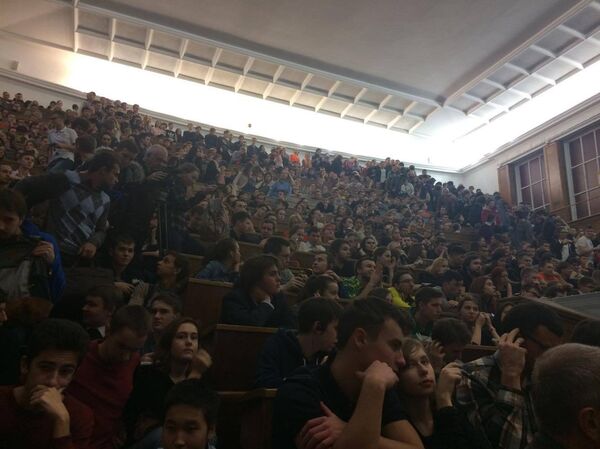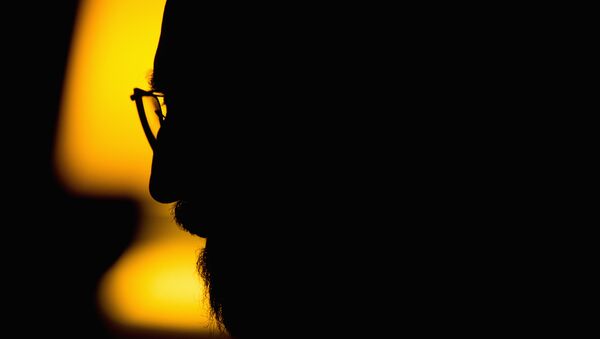The main Physics lecture hall of Moscow State University was abuzz as students gathered to listen to one of our era's most renowned astrophysicists, who's brought us scientific breakthroughs and spectacularly trustworthy Sci-fi alike: Kip Thorne.
Gravitational waves can be a tough concept to grasp: how can matter curve the fabric of spacetime? We asked Thorne if there's a "for dummies" way of explaining them, and here's what he had to say:
"They stretch and squeeze space."
Back in September 2015, LIGO made an unexpected breakthrough and registered gravitational waves for the first time. The team was as surprised as the rest of the world: the detectors were just being tested, the actual hunt was only supposed to begin much later. But, as Thorne himself says, researching gravitational waves only promises one thing for certain: "Surprises." A year on after LIGO spotted gravitational waves, the researchers are perfecting their equipment to bring humanity a step closer to studying the universe on a whole new level.

"We've discovered two other signals that I've described. That search lasted from September to January. Since January, the team has been working to remove noise from the detectors, the unexpected noise and the detectors are now being brought into engineering mode in preparation for the second search. So we haven't learned anything except how to remove some of the noise," Thorne told Sputnik.
According to Thorne, we might be catching new signals on a daily basis in the foreseeable future, but the current equipment is not quite there yet.
"We've been improving the detectors, the hardware. One of the lasers had failed and had to be replaced. Unexpected forms of noise in some of the instrumentation had to be changed to fix that. The detectors are being improved in order to remove these forms of noise so that we have better sensitivity […] So there's nothing to report yet."
Studying the phenomena that Einstein theorized about back in 1916, and it took a whole century to prove, can offer mankind an almost whole new sense to explore our galaxy and beyond: scientists will be able to do mind-blowing things like precisely mapping the horizon of the giant black hole in the center of the Milky Way. And while registering gravitational waves mainly helps with pure research, the research offers very practical "spin-offs" as well:
"A lot of technology has been developed […] For example, the technique that is now used most widely for stabilising a laser to make its frequency pure was invented for LIGO. So, these are technological spin-offs."
Bringing Science to the Masses
Thorne is famous for his tireless efforts to make such complex concepts like Relative Physics comprehensible to mere PhD-free mortals:
"The real purpose of LIGO is to help us understand the universe, to give to our children an understanding of the universe much better than we had when we were beginning."
However, his biggest success in popularizing science is likely the modern classic, Interstellar. While the science behind the visualizations of black holes and wormholes is phenomenal, Thorne told Sputnik about his particular favorite in the film when it comes to making Relative Physics, well, relatable:
"In the movie, perhaps, it was the warping of time. It's very powerful when you see Cooper age by only a few months and his daughter ages first by 20 years and then by an additional 50 years because he's gone near a black hole. This is Relativity Physics, but it Relativity Physics that is now part of the culture, of world culture because of this movie. I think that in some ways is the most powerful piece of science in the movie, and it's powerful because it's emotional"
New Horizons
And, we might soon be in for another treat! Thorne is working on a big new project with Stephen Hawking and Linda Obst, and shared his take on how ticket sales help spread science:
"I've learned making Interstellar that the giving of information on what's happening has to be controlled by the studio. They know best how to create the excitement that will sell the maximum number of tickets. Now, for them selling the maximum number of tickets is important because they make more money. For me, it's important because I can have a bigger impact on people in appreciating and being excited by science, so I will tell you what I am allowed to tell you about my second movie, and I am not allowed to tell you anything more."
Although it's a all very hush-hush in the initial stages of development, we managed to get a small scoop:
"I've written a treatment, I've written it together, again, with Linda Obst, and with Stephen Hawking. We now have a studio, we have a director and we're very close to having a screenwriter […] I cannot tell you who the studio is, I cannot tell you who the screenwriter is except that they're names that you've probably heard of. This does not involve the Nolans, it's not a sequel to Interstellar. It will be a science fiction movie that has new science in it, exciting science. I hope that, like Interstellar, it will be an inspiration for people around the world."


